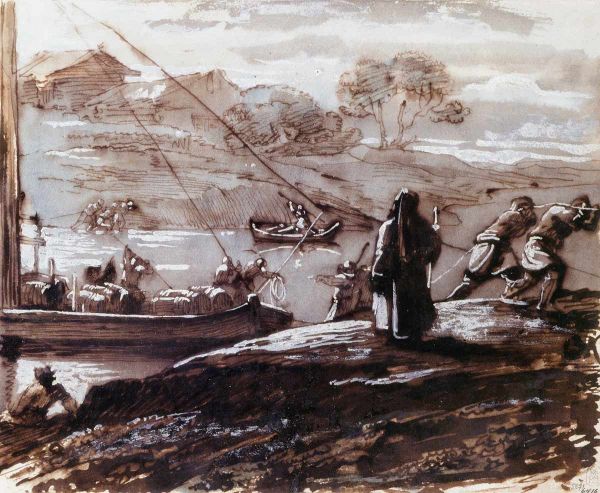|
|
Landscape with Barge Haulers. First half of the 1810s

Kiprensky Orest,
Watercolours, bistre, brush and white chalk on paper
20 x 24
State Russian Museum
Annotation
This is one of the best-known works of graphic art by Orest Kiprensky. The motif of the river as a symbol of life and the slowly moving barge were important metaphors for the Romantic artist. Unlike eighteenth-century landscapes and many views of the first half of the nineteenth century, this work is almost monochrome. The entire scene is drawn on a small piece of pale-yellow paper covered in lightblue watercolours. The white chalk creates the effect of reflected moonlight. The unfinished nature of the drawing and the way in which the artist appears to capture a chance moment from the general passage of life are typical features of Romantic art.
Author's Biography
Kiprensky Orest
Kiprensky, Orest Adamovich
1772, Nezhinskaya (St Petersburg Province) - 1836, Rome
Portraitist, history painter, draughtsman. Illegitimate son of a serf woman, Anna Gavrilova, who gave him the name Kipreisky, later changed to Kiprensky. Grew up in the family of his foster father Adam Schwalde. Emancipated from serfdom and enrolled in the Imperial Academy of Arts (1788). Studied history painting under Grigory Ugryumov and Gabriele-Francois Doyen. Fellow of the Imperial Academy of Arts (1803-09). Worked in St Petersburg, Moscow and Tver. Academician of portrait painting (1812), councillor of the Imperial Academy of Arts (1815). Contributed to the exhibitions of the Imperial Academy of Arts. Lived in Italy (1816-23, 1828-36). Contributed to the Paris Salon (1822). Donated Self-Portrait (1820) to the Galleria degli Uffizi in Florence (1825). Appointed second-class professor of history and portrait painting with automatic member¬ship of the nobility (1831). Councillor of the Accademia di Belle Arti in Naples (1831). Buried at Sant'' Andrea delle Fratte in Rome.

